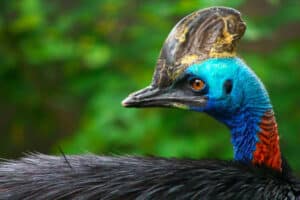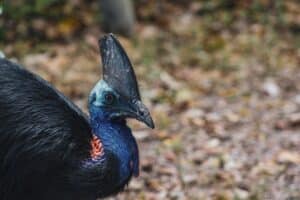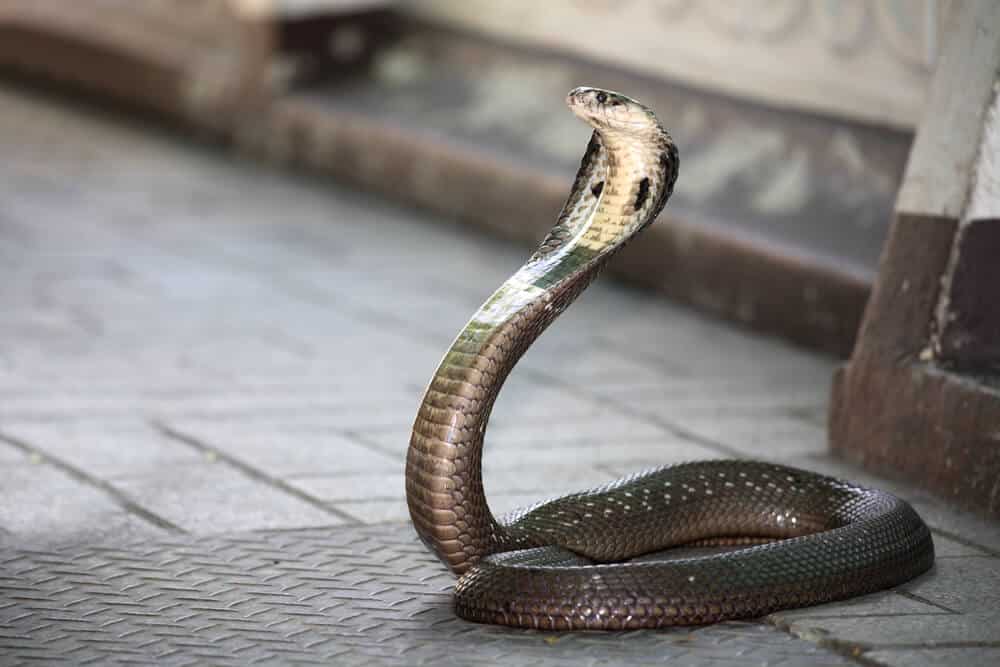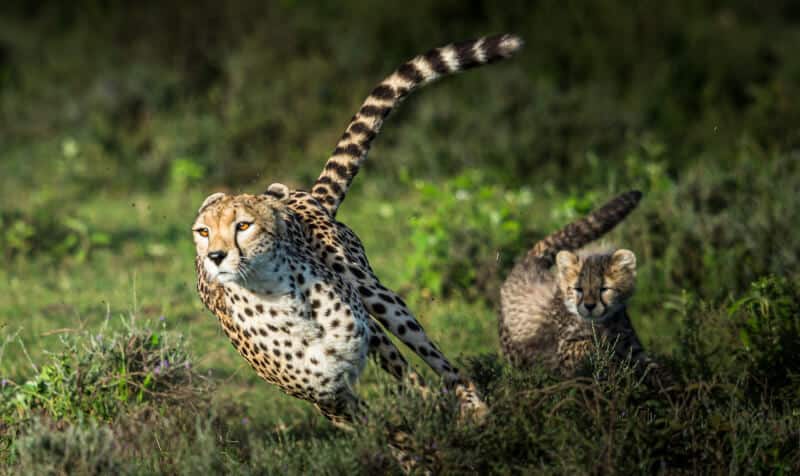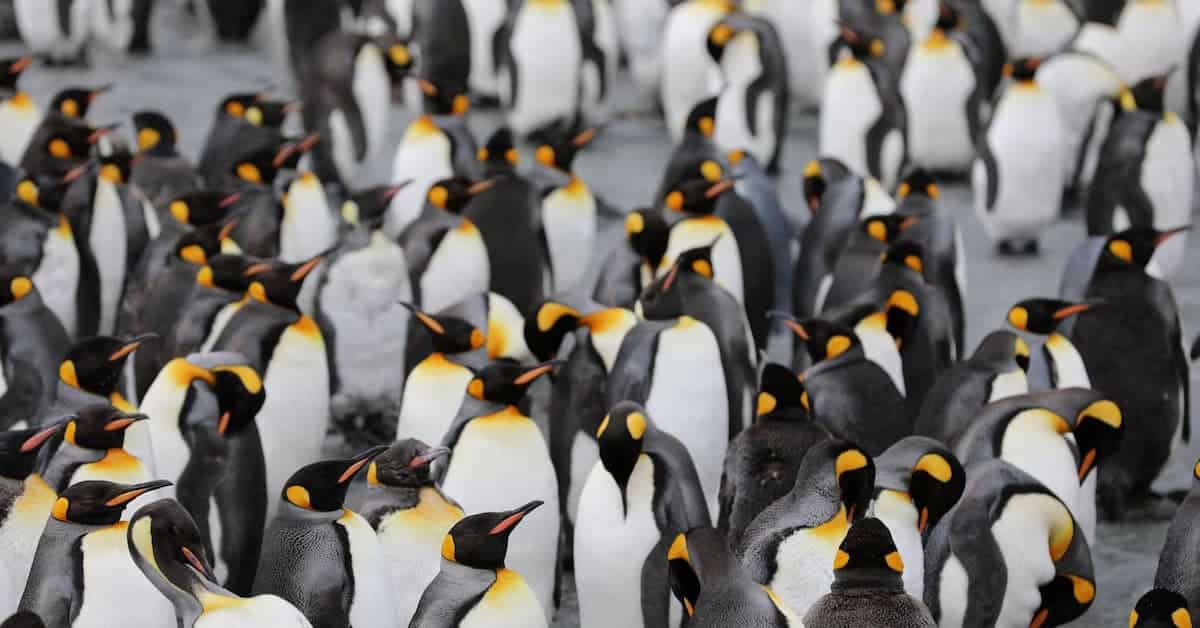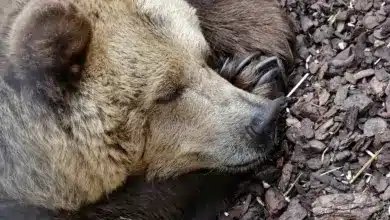Cassowary Bird: Animal Fact File
Cassowary Bird: Animal Fact File (The Most Dangerous Bird in The World?)
Gazing upon this magnificent creature might convince some they are looking at an extinct dinosaur species and not a living bird. Native to tropical forests of New Guinea, Indonesia, and Northern Australia, the cassowary is physically imposing.
Grouped as a ratite, the cassowary’s closest relation is the emu, but other members of this group include ostrich, rhea, and kiwi. As feathered, flightless birds, ratites lack a keel—the bony protrusion of the sternum that provides attachment for birds’ flight muscles.
This incredible bird has evolved under unique circumstances and thus, has some extraordinary traits and physical adaptations.
| Cassowary Taxonomy | |
| Class | Aves |
| Infraclass | Palaeognathae |
| Order | Casuariiformes |
| Family | Casuariidae |
| Genus | Casuarius |
| Species | Southern cassowary: Casuarius casuarius
Northern cassowary: Casuarius unappendiculatus Dwarf cassowary: Casuarius bennetti |
| Cassowary Quick Facts | |
| Lifespan | 40–50 years |
| Distribution | Papua New Guinea, Indonesia, Australia |
| Speed | 50 km/h (30 mph) |
| Maturity | 2.5–3 years |
| Breeding season | May to June |
| Clutch size | 3–5 |
| Egg size | 20 ounces |
| Incubation period | 49–56 days |
| Diet | Fruit, flowers, fungi, insects, frogs, birds, fish, and rodents |
| IUCN conservation status | Least concern |
| Comparison of Cassowary Species | |||
| Southern Cassowary | Northern Cassowary | Dwarf Cassowary | |
| Weight | 30–60kg (66–132lb) | 30–60kg (66–132lb) | 18–30 kg (36–60lb) |
| Height | 1.5–1.8m (4.9–5.9ft) | 1.5–1.8m (4.9–5.9ft) | 99–150cm (3.25–5ft) |
| Beak length | 9.8–19 cm (3.9–7.5 in) | 12 –13.7 cm (4.7–5.4 in) | 11–12.2 cm (4.3–4.8 in) |
| Population size (estimated) | 20,000-50,000 (declining) | 3,500-15,000 (declining) | Unknown |
| Distribution | Indonesia, Papua New Guinea, northeastern Australia | New Guinea, islands of Yapen, Batanta, Salawati. | New Guinea, New Britain, Yapen Island |
| Wattle | Double-wattle | Single wattle | No wattle |
A Sight to Behold
Coloration
The jet-black body of the cassowary sharply contrasts their colorful necks, faces, and wattles. Blue is the predominant color, with both southern and northern species displaying deep blue necks with red wattles.
The dwarf cassowary has the same blue skin on the face but tapers down to a vibrant orange neck. This coloration and significantly smaller size set these subspecies out of the group.
Feathers
Cassowary feathers have loose barbules, giving a shaggy, hair-like appearance. Lack of barb connection causes a lack of feather vane, so feathers don’t require preening with oil from preening glands.
Flightless ratites don’t need their feather barbs to lock together smoothly for flight aerodynamics. They have subsequently lost their preening glands as well as tail feathers.
Reduced cassowary wings have five or six extending primary feathers, which have been reduced to stiff keratin structures resembling quills.
Body Structure
Cassowaries and other rarities lack the presence of a “wishbone,” which acts as a thoracic strengthening bone for the pressure of flight on the abdomen.
Their “wedge” wedge-shaped body allows for quick movement through dense vegetation. Cassowaries duck their heads and run full speed to advance quickly through the forests, bashing through the foliage. This fearless running leads them to run directly into trees often. Good thing they have an inbuilt helmet!
Protective Headgear
A cassowary “helmet” is a prominent physical feature of this species. Called a casque, the true function of this adaptation is unknown. Theories include:
- A sexual characteristic (females have larger casques)
- Protection during confrontation
- A foraging tool to push aside leaf litter
- A bush-bashing device to navigate dense forests
- Amplification for vocalizations
- Protection from falling fruit
While these functions are disputed, the likelihood is they all hold some truth. Studies on cassowary vocal frequencies substantiate the vocalization theory.
Other species, such as the hornbill, use a casque to increase the range of their vocalizations. The cassowary call is the lowest known call of any bird, so low that it is almost out of the range of human hearing.
Evolution of Ratites
Flightlessness in birds usually evolves when the species lacks predation and does not require flight as an escape route. However, there were plenty of predators in the supercontinent Gondwanaland, where ratites first evolved.
It’s theorized that Ratites have lost their ability to fly during a mass extinction event that drastically reduced predators. From here, selection brought forward the largest and strongest birds to occupy ground habitats.
Flight loss offered energy-saving benefits such as:
- No air sacs in bones
- Lower metabolic rate
- Reduction of pectoral muscles.
General ratite speciation occurred across the globe during the break up of Gondwanaland. Zealandia broke away first, creating the kiwi bird, which is vastly different than modern ratites.
The cassowary evolved long, solid legs for quick movement and powerful defending kicks. Their identifiable “helmet,” known as a casque, has varying benefits, but it most likely helps vocalize dense forest habitats.
Star of The Show
Three species of cassowary still roam the earth: the southern cassowary, the northern cassowary, and the dwarf cassowary. There is one additional extinct species known, the pygmy cassowary.
The most common is the southern species. They are the third-tallest bird and the second-heaviest, only behind the emu and ostrich. This species is often seen in zoos and media as they are the most abundant and striking.
Cassowary Diet and Ecosystem Impact
Cassowaries are primarily frugivores, sustaining themselves on various fruits and berries of the forests. Technically, they are classified as omnivores as they often eat insects and opportunistically hunt rodents, small birds, and fish.
Their love for fruit has earned them an influential place within their ecosystems. They are vital seed dispersers for the habitats that they occupy.
Some plant species have also evolved alongside the cassowary. A rare Australian tree, Ryparosa, germination rates boost from 4% to 92% after passing through the gut of a cassowary.
Behavior
A Force to Be Reckoned With
For a species so wary of humans, the title of “world’s most dangerous bird” seems strange. Cassowaries avoid confrontation and human interaction as much as possible, staying away from settlements.
However, when confronted in any way, the cassowary shows little fear and will directly return any perceived challenges with an immense threat. Responding to aggression, the cassowary can deal fatal damage to animals and humans alike. Behind their kicks are powerful legs and an elongated claw of around 5 inches on each foot.
They are even more fearsome than they look, able to perform amazing physical feats such as running up to 50km/h (30mph) and jumping up to 7 feet in the air. They are also adept swimmers, taking to rivers and oceans to cool down.
They have killed humans in the past, including inexperienced owners who have kept them as exotic pets in the United States. Zookeepers treat them like other dangerous animals such as apes and lions by not entering an occupied enclosure.
Girl Power
Female cassowaries are larger than males. This sexual dimorphism is the same across all ratite species, and this size supports females to carry and lay enormous eggs.
Some theories speculate that males are smaller as they hunt abundant prey more when the females are incubating eggs. This thought doesn’t fit the behavior of some ratites, including cassowary and kiwi, where the male incubates the eggs, not the female.
Female cassowaries maintain a sizable territory that overlaps with smaller territories of multiple males. She prioritizes her time in mating and egg production with a handful of mates, leaving them to hatch and protect the young.
Angry Introverts
Thankfully for humans and other animals, this aggressive bird mostly keeps to itself. They tend to avoid most interactions, even amongst their own kind. Cassowaries are primarily solitary, only coming together for copulation and subsequent egg-laying.
Habitat is to blame for the loss of species range as each male occupies a range of up to 7 km2 (1,700 acres), while females have larger territories that overlap in those of multiple males.
Cassowaries are also not fond of making new friends. Females are highly aggressive with each other and often stay in the same territory range, mating with the same males for their whole life.
A Modern Day Love Story
A copulation between pairs follows drawn-out courtship rituals. These begin with vibrational sounds shared between the couple, followed by the male’s display.
He will run towards the female with his neck close to the ground, swooping it upwards on approach to show off his stunning coloration.
The male drops to the ground as the female approaches while she considers her options by placing a foot on his back. Here she either chooses to crouch and begin copulation or begins to attack him.
Her aggression can result in chasing, which ultimately ends when the male dives into a water source and subdues the female in the shallows. His dominance here then allows for copulation. Sometimes, another of her nearby mates may approach and chase away the first male, picking up where he left off.
Final Thoughts: Protecting The Future of The Cassowary
While none of the three cassowary species are currently listed as under threat by the IUCN, this only speaks to their overall populations. Many are at risk of habitat loss and are declining in their natural ranges.
Humans encroaching on their habitat puts them at risk also, with vehicle impacts resulting in large numbers of fatalities. Habitat clearing for farmland puts pressure on populations, causing these territorial animals to squeeze together.
Protecting future populations will be driven by consumer changes of unsustainable consumables, such as palm oil, and accredited facilities’ support in the cassowary Species Survival Plan.

